Floral Illumination: Merging Nature and Light
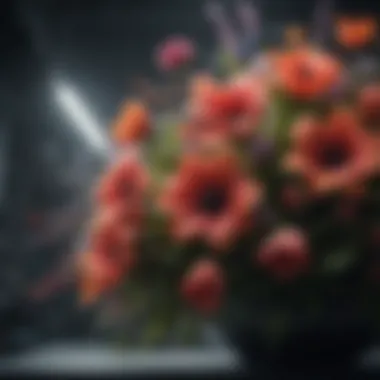
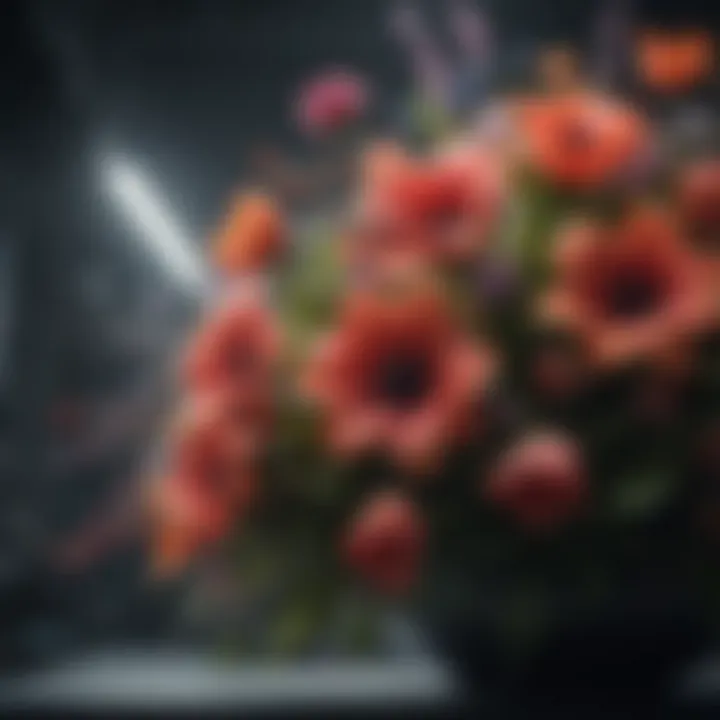
Intro
The amalgamation of flora and illumination stands as a captivating frontier in design and environmental aesthetics. In recent years, the convergence of flowers with lights has unfolded into a dynamic field that intersects art, technology, and ecology. This integration not only enhances the visual appeal of spaces but also imparts emotional depth and functional utility.
As we navigate this topic, we will explore the scientific and practical applications of illuminated flora. We strive to present a balanced examination that caters to students, researchers, educators, and professionals interested in this innovative aspect of design. By focusing on current methodologies and novel techniques, we aim to uncover the significance of integrating light with floral designs, elucidating both its artistic and functional roles.
Research Overview
Methodological Approaches
In exploring the integration of flowers and light, a mixture of qualitative and quantitative research methods have proven most effective. By employing observational studies, case studies, and surveys of both decorators and consumers, researchers gain insights into preferences and trends. For instance, understanding how ambient light influences the perception of floral arrangements can guide better design practices.
Furthermore, scientific experiments in botanical research have incorporated advanced illumination techniques. These studies often utilize LED technology for investigating plant growth and behavior under different light wavelengths, bridging the gap between horticulture and design. By analyzing these methodologies, one can appreciate the multifaceted impact of light on floral aesthetics.
Significance and Implications
Illuminated flora is more than mere decor; it holds practical implications in various sectors. For event planning, integrating light with floral arrangements enhances ambiance, significantly affecting mood and experience. In ecological studies, lighting assists in plant growth experiments, expanding horizons for agricultural innovations.
The intersection of flowers and illumination represents a unique synergy that can redefine spaces while contributing to ecological insights.
Recognizing these implications allows designers and researchers to rethink traditional uses of plants and light. This holistic understanding can potentially lead to sustainable practices that benefit both the environment and society.
Current Trends in Science
Innovative Techniques and Tools
Current developments in design and science have birthed innovative techniques that optimize the interaction of flowers and light. Technologies such as smart lighting systems allow customizable illumination that can adjust to environmental conditions. Additionally, researchers are leveraging OLED technology to create energy-efficient lighting solutions integrated directly into floral displays.
Tools such as 3D modeling software enable designers to visualize their concepts, enhancing artistic execution. These advancements not only improve aesthetic appeal but also ensure sustainability in practices.
Interdisciplinary Connections
The fusion of floral aesthetics and lighting technology encourages interdisciplinary collaboration among designers, botanists, and engineers. Research initiatives often bring together these diverse fields to develop new products or systems. This cooperation is vital for understanding how light can accentuate the beauty of plants, while also ensuring the health and growth of these living organisms.
Ultimately, the intersection of flora and illumination leads to noteworthy advancements in design principles and ecological research. It encourages a shift in how we perceive and utilize both flowers and lighting, pushing the boundaries of conventional understanding.
Prologue to Flowers with Lights
The integration of flowers with illumination represents a fascinating intersection of nature and technology. The emergence of light-enhanced florals goes beyond mere aesthetics; it offers numerous benefits that can impact environmental design, emotional well-being, and even horticultural practices. Understanding this topic is crucial because it reflects a broader trend in design and technology, where functionality and beauty intertwine.
From enhancing the ambiance of spaces to improving plant growth, the implications of flowers with lights are vast. Specifically, it allows for greater creativity in floral arrangements and designs. Moreover, it presents opportunities for sustainable practices in horticulture, making it essential for students, researchers, educators, and professionals to explore these innovations.
Defining the Concept
Flowers with lights can be defined as flora equipped with various illumination technologies for decorative or functional purposes. This concept combines traditional botany with cutting-edge technology, resulting in combinations that can change how we perceive and utilize plants. Illumined flowers can be incorporated into both indoor and outdoor environments, creating visually striking displays. The lights may serve to highlight specific flowers, enhance visibility at night, or even contribute to the growth of the plants themselves through photonic interactions.
Historical Context
The use of light in conjunction with plants has a rich history. Traditional practices included using candles or lanterns to illuminate gardens during events or festivals. As technology progressed, electric lights allowed for more elaborate designs. The introduction of LED technology revolutionized this area by providing energy-efficient and versatile options for illumination. Such advances not only improved aesthetic appeal but also enabled new forms of artistic expression in floral design. Today, the integration of lights in horticulture represents a modern evolution, influenced by trends in sustainability and smart design.
The Science Behind Light Integration
The integration of light with flora is a fascinating topic that bridges science, art, and technology. Understanding the science behind light integration is crucial for several reasons. First, it offers insights into how different light sources affect plant life, which can enhance growth and health. Second, integrating lighting significantly changes aesthetics and emotional responses to spaces adorned with illuminated flowers. Lastly, understanding the technical aspects of illumination aids in developing sustainable and innovative horticultural practices.
By examining the interaction between light and plants, we can unlock potential applications that benefit both our environment and our sensory experiences.
Photosynthesis and Light Influence
Photosynthesis is the process by which plants convert light energy into chemical energy. It is vital for plant growth and is directly influenced by the quality, duration, and intensity of light. The light spectrum plays a role in photosynthesis as well. For example, red and blue wavelengths are particularly effective for chlorophyll, the green pigment crucial for this process.
When integrating artificial light into horticulture, understanding how different light spectra affect plant health is essential. Proper lighting can enhance photosynthesis, thus promoting growth and flowering in various species. This technology has profound implications for indoor gardening and agriculture, leading to increased yields and enhanced plant health.
Types of Illumination Techniques
Innovative illumination techniques have emerged to enhance the interaction between light and flowers. Among these techniques, LED technology, fiber optics, and smart lighting systems play prominent roles.

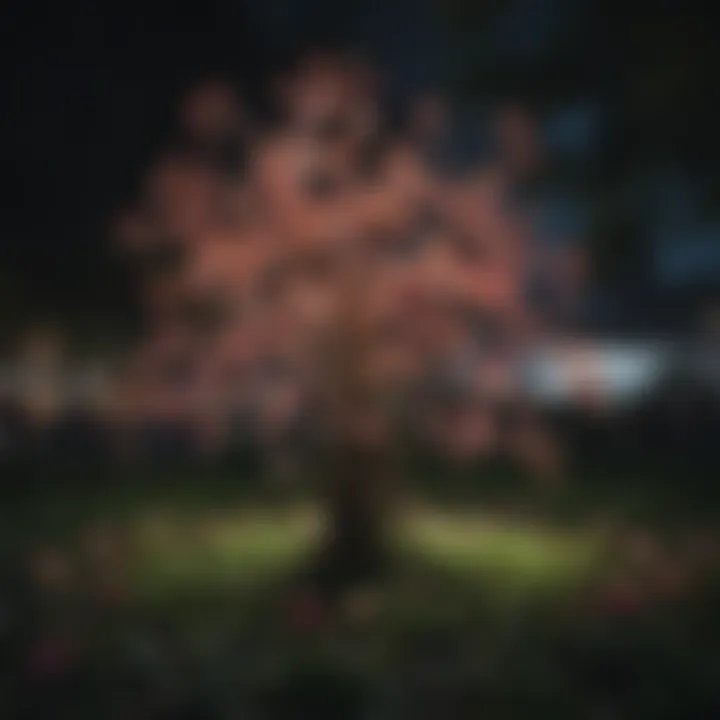
LED Technology
LED technology is a key player in the light integration field. Its energy efficiency and versatility make it an excellent choice for growing plants indoors. LEDs can emit specific light wavelengths, tailored for different growth stages of plants.
A prominent feature of LEDs is their low energy consumption, allowing for longer durations of operation without significantly increasing power costs. Furthermore, they generate less heat than traditional lighting options, reducing the risk of heat damage to delicate flower structures. However, while LED systems can be more expensive initially, their long-term savings and effectiveness often justify the investment.
Fiber Optics
Fiber optics offer a unique method of integrating light into floral displays. They allow light to travel through flexible strands, creating visually distinct effects without excessive heat production. The ability to bend and manipulate these fibers makes them ideal for creative floral arrangements.
This technique can be aesthetically pleasing, as they enable lighting effects to blend seamlessly into plants and flower arrangements. However, one drawback of fiber optics is that they may require frequent maintenance and replacement.
Smart Lighting Systems
Smart lighting systems represent the cutting edge of illumination technology in floral design. These systems allow for automation, customization, and remote control, enabling users to adjust light parameters according to specific plant needs. This adaptability can ensure optimal lighting conditions at all times.
A unique feature of smart systems is their integration with technological ecosystems, allowing for data-driven decisions regarding light usage. Compared to standard lighting setups, smart lighting can lead to more efficient energy usage. While the initial setup may be complex, the long-term benefits often outweigh the challenges.
The fusion of technology with nature through light integration opens new avenues for both aesthetic beauty and functional growth in horticulture.
By understanding and utilizing these various illumination techniques, designers and horticulturists can effectively enhance the visual impact of flowers while promoting their health and growth.
Applications in Horticulture
The integration of illumination technology within horticulture presents fascinating possibilities. This approach not only enhances the aesthetic appeal of flowers but also improves growth conditions and functional applications. By examining the ways in which light can influence plant performance and decorative aspects, one can appreciate the multifaceted benefits of using illuminated flowers in various settings. Examples of applications include enhancing growth environments and creating visually captivating displays that serve both practical and artistic purposes.
Enhancing Plant Growth
Utilizing light in horticulture plays a critical role in plant growth. Plants rely on photosynthesis, a process that converts light energy into chemical energy. This interaction is fundamental to plant vitality and productivity. Certain light spectrums can enhance photosynthetic rates, leading to improved growth and health of plants.
When using technology, options like LED lighting are often favored for their efficiency and effectiveness. These systems can be tailored to emit specific wavelengths that encourage flowering or root development. For example, blue light can promote vegetative growth, while red light can induce flowering in many species.
Furthermore, dynamic light systems allow for adjusting intensities and durations to mimic natural conditions, providing optimum growth scenarios regardless of external weather influences. The close observation of plant responses to these changes can help refine growth strategies. Thus, the integration of light into horticultural practices can lead to more abundant and healthier crops.
Creating Attractive Displays
The visual impact of illuminated flowers cannot be understated. They serve as intriguing focal points in gardens, events, and commercial displays. The interplay of flowers and light creates an engaging atmosphere that can transform ordinary spaces into extraordinary experiences.
Using lights in design presents several options. For instance, incorporating fiber optics can create unique, shimmering visual effects that draw the viewer’s attention. Smart lighting systems enable designers to create dynamic displays that change with the seasons or time of day, enhancing the overall experience. Moreover, illuminated floral arrangements can be used in nighttime events, ensuring that beauty is not restricted to daylight hours.
It is important to consider the balance between lighting and the natural beauty of the flowers. Too much intensity can overshadow the plant's unique characteristics. Therefore, a thoughtful design approach is essential to highlight both the illumination and the flowers themselves. Incorporating light enhances the overall aesthetic appeal while showcasing the intricate textures and colors of the plants.
"The combination of flowers and light elevates the experience of observing nature and creates an emotional connection with the audience."
Cultural Significance of Illuminated Flowers
The integration of light into floral displays transcends mere aesthetics. It carries layers of meaning within various cultures. Illuminated flowers hold a unique place in societal rituals, celebrations, and artistic expressions. Understanding this cultural significance offers insight into the relationship between people and nature, as well as the technological evolution in floral design. The interplay of light and nature can evoke emotional responses that resonate across different settings and traditions.
Symbolism in Different Cultures
Flowers have long been symbols of particular emotions and values. When illuminated, these symbols can gain new layers of meaning. In Asian cultures, for instance, cherry blossoms signify beauty and transience. Illuminating cherry blossoms for festivals accentuates their ethereal quality, reflecting the fleeting nature of life.
Similarly, in Western traditions, roses often represent love and passion. When used in events like weddings, light-infused rose arrangements can enhance romantic atmospheres, making such occasions even more memorable. Each culture also has its own rituals that may incorporate illuminated flowers, from Chinese lantern festivals to Diwali celebrations in India, where lights symbolize the triumph of light over darkness.
"Illuminated flowers serve not just as decor; they communicate messages steeped in cultural heritage."
As communities evolve, these symbols adapt. Illuminated flowers have found their way into contemporary art, reinforcing their relevance. Artists and designers utilize them to challenge perceptions and convey themes of hope, nostalgia, or even environmental awareness. By forging connections with the audience, illuminated floral designs can serve as powerful conduits for cultural expression.
Usage in Celebratory Events
Illuminated flowers are far from being just decorative pieces; they are essential in numerous celebratory events. From weddings to festivals, their glow brings a certain magic to the occasion.
- Weddings:
- Festivals:
- Public Celebrations:
- Floral installations can create enchanting backdrops, enhancing vow exchanges and receptions.
- Mood lighting from flowers can complement themes and color palettes, contributing to a unified aesthetic.
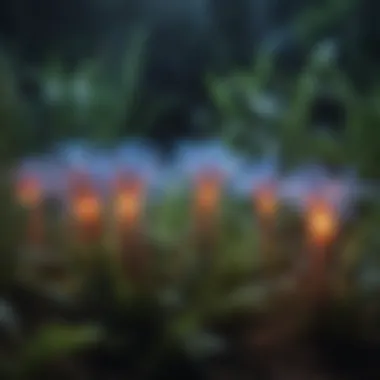
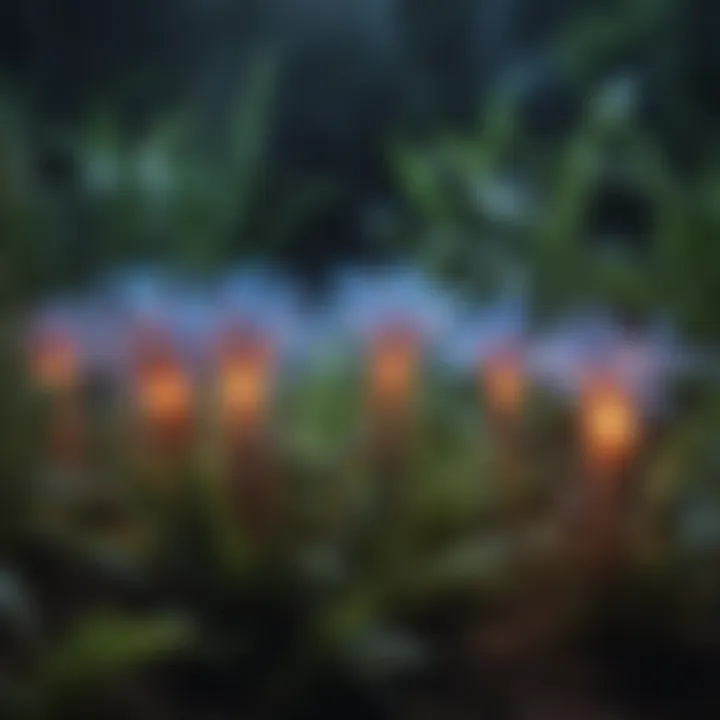
- Major events like the Japanese Hanami, or cherry blossom viewing, are transformed when flowers are lit at night, attracting crowds and boosting local economies.
- Festivals such as Luminara in Italy, where illuminated flowers line the streets, blend tradition with modernity, promoting community togetherness and festive spirit.
- Events like Christmas see illuminated floral arrangements as part of decor in homes and public spaces, symbolizing joy and unity during the festive season.
- Incorporating floral light displays in parades and public gatherings fosters a sense of belonging and shared joy.
In summary, the cultural significance of illuminated flowers extends beyond their visual appeal. They embody historical meanings and adapt to social dynamics, making them a compelling feature in both personal celebrations and larger cultural events.
Design Considerations for Lighted Florals
Designing with lighted florals involves intricate choices that can greatly influence the overall impact of floral displays. Successful integration of flora and light requires an understanding of how aesthetic elements and safety concerns interact. The visual appeal of illuminated flowers can attract attention and create desired atmospheres, while careful planning for safety and durability ensures the longevity of installations.
Aesthetic Choices
Aesthetics are crucial when it comes to flowers with lights. Designers must consider how different light types can enhance floral features. For instance, warm white lights can create a soft and inviting ambiance, perfect for receptions or weddings. In contrast, cool white lights may be used for more modern settings, emphasizing sleek designs.
In addition to color temperature, the placement of lights is vital. Lights can be embedded within flower arrangements or placed around them. LED strip lights used along the base of arrangements can add depth and interest. Moreover, the color of the light itself can complement or contrast the natural hues of the flowers. This consideration is key in crafting visually striking displays.
Patterns of light and shadow also play a role. Strategically positioned lighting can highlight specific flowers, creating focal points. Additionally, layering different light sources can produce dynamic displays that change with time or angles from which they are viewed.
The choice of control mechanisms, like dimmers or smart lighting systems, can further enhance aesthetic choices. These allow for adjustments in brightness and color, enabling creators to adapt the mood for different occasions.
Safety and Durability
Safety is an imperative aspect when designing lighted flower displays. Heat generated by light sources, particularly traditional bulbs, can pose fire hazards. Hence, using LED lights is recommended because they produce minimal heat and have a longer lifespan. They are energy-efficient and reduce overall energy consumption, aligning with sustainable practices.
Durability also needs to be addressed both in terms of the materials used for the flowers and the lighting systems themselves. Artificial flowers made from UV-resistant materials can help to prevent fading when exposed to light for extended periods. Likewise, weather-resistant fixtures are needed for outdoor displays to withstand environmental conditions.
It is also important to consider how lighting systems are powered. Utilizing battery-powered lights or solar options can provide flexibility and minimize safety risks related to cords and electricity.
In summary, thoughtful design in both aesthetics and safety can yield floral lighting installations that are not only beautiful but also functional and secure. This balance is essential for long-lasting and visually appealing floral arrangements that incorporate illumination.
Technological Innovations in Floral Lighting
Technological innovations play a crucial role in the evolution of floral lighting. The growing integration of illumination technologies within floral design not only elevates aesthetics but also enhances the functionality of plants in various applications. This section explores how advancements in technology—such as nanotechnology and smart systems—are influencing the field, creating a more sustainable and visually appealing approach to floral illumination.
Nanotechnology in Plant Illumination
Nanotechnology has emerged as a groundbreaking field that offers new possibilities in plant illumination. By manipulating matter at the nanoscale, researchers can develop materials and devices that enhance the interaction between light and plants.
Key benefits include:
- Improved Light Absorption: Nanoparticles can be designed to modify light properties, optimizing how plants absorb light for photosynthesis.
- Enhanced Plant Growth: Through the use of specific nanomaterials, it is possible to influence plant growth rates and improve overall health.
- Energy Efficiency: Nanotechnology allows for the creation of more efficient lighting systems that require less energy while providing adequate illumination.
One example of this innovation can be seen with the application of quantum dots, which can produce specific wavelengths of light that optimize the growth of certain plant species. Additionally, nanostructured coatings can enhance the performance of light sources, extending their lifespan and reducing maintenance costs.
Smart Systems for Maintenance
The advent of smart systems has significantly transformed the landscape of floral illumination by introducing automation and intelligent monitoring into plant care. These systems utilize sensors, algorithms, and connectivity to streamline maintenance processes.
Important features of smart systems include:
- Real-time Monitoring: Sensors can track light levels, moisture, and various environmental conditions, allowing for data-driven decision-making in plant care.
- Automated Adjustments: These systems can autonomously adjust lighting based on the needs of the plants, ensuring optimal conditions for growth.
- Remote Access: Users can control and monitor their floral systems from anywhere, making it easier to maintain complex installations.
"The fusion of technology with horticulture will not only advance floral displays but also facilitate sustainable practices in light management."
The long-term implications of these technologies point toward a more efficient way to grow and display flora, with an emphasis on sustainability and adaptability. As innovations continue to evolve, the future of floral lighting seems promising, linking aesthetics with cutting-edge technology.
Case Studies
Case studies play a critical role in understanding the practical applications of flowers with lights. These real-world examples showcase how integrated floral illumination can transform spaces, evoke emotions, and enhance user experiences. By analyzing specific instances, we can draw valuable lessons on design considerations, effectiveness, maintenance, and audience reception.
Event Installations
Event installations utilizing illuminated flowers often aim to create an immersive experience. Such installations can be seen in festivals, weddings, and corporate events. Designers must consider not only the aesthetic appeal but also the function.
- Visual Impact: Illuminated flowers capture attention. They often serve as focal points at an event, guiding attendees through the space.
- Mood Setting: The right lighting can evoke specific feelings, underlining the event's theme. For example, warm lighting may create a cozy atmosphere, while cool tones can emphasize modernity.
- Safety Features: It’s important that lights are integrated safely. For instance, wiring must be secure, and materials should be flame-retardant.
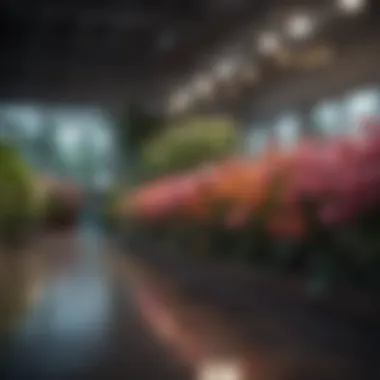
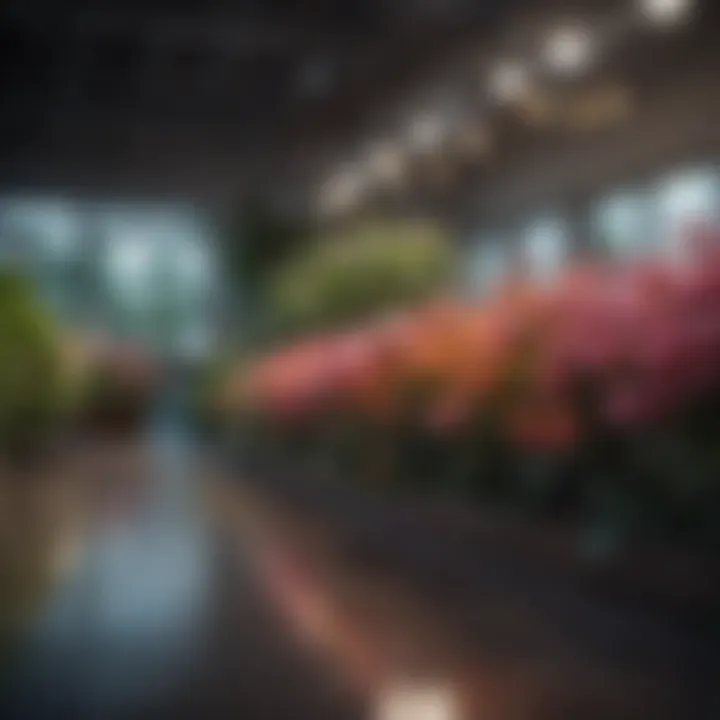
In one striking installation during a botanical garden’s annual festival, stunning arrangements of lighted orchids transformed an outdoor space into a magical experience. Visitors remarked on the merging of nature and technology, elevating their connection to the environment.
Commercial Displays
Commercial displays present another significant area where illuminated flowers can be leveraged. Retailers and businesses utilize these displays to attract customers and convey brand identity.
- Brand Engagement: Unique floral lighting designs can draw attention to products. For example, a cosmetics store might use illuminated roses to represent beauty and luxury.
- Seasonal Promotions: Many businesses incorporate lighted floral arrangements during holidays. They add a festive touch and encourage customers to take part in seasonal shopping.
- Durability Considerations: Since commercial settings demand longevity, choosing materials that withstand various elements becomes essential.
A notable case is a high-end florist that integrated LED arrangements into their storefront window. This approach successfully increased foot traffic, demonstrating how effective design can impact sales.
"The fusion of lighting and flowers results in a dynamic aesthetic. It not only beautifies but can attract business in a competitive market."
Environmental Impact of Lighted Flowers
The integration of light with floral designs presents both opportunities and challenges concerning environmental stewardship. In today's world, where sustainability is paramount, understanding how these illuminated flora contribute to ecological health is essential. This section explores the energy implications, sustainable practices, and the overall impact on the environment when using flowers with lights.
Energy Consumption Analysis
The use of illumination in floral displays often raises questions about energy consumption and its ecological footprint. Traditional lighting sources, like incandescent bulbs, consume more energy and emit heat, impacting the surrounding environment. However, advancements in technology, particularly the adoption of LED lighting, have transformed this scenario.
LED lights are not only energy-efficient but also have a longer lifespan compared to conventional bulbs. They consume significantly less power, which translates into lower energy bills and reduced greenhouse gas emissions. For instance, using LED lights instead of incandescent bulbs can reduce energy consumption by about 75%. This shift also minimizes the demand on electrical grids, especially in decorative installations during high traffic seasons, such as holidays.
Moreover, it's important to consider the location and usage of lighted flora. Examples include public gardens, homes, or event spaces. Assessing the overall impact involves studying the lighting patterns, duration of use, and the specific technologies employed. An effective energy consumption analysis would detail not only the kilowatt-hours used but also how these installations can operate on renewable energy sources, such as solar panels, further minimizing their environmental impact.
Sustainable Practices
Sustainability in floral lighting goes beyond energy efficiency; it encompasses various practices that align with environmental conservation. One key approach is the selection of materials used in the production of lighted floral designs. Opting for biodegradable materials over plastics can significantly reduce waste. Similarly, incorporating recyclable components into the lighting fixtures promotes a circular economy.
Another critical area is the maintenance of these installations. Smart lighting systems can be programmed to adjust brightness based on ambient light conditions. This functionality not only conserves energy but also extends the life of the flowers involved.
Incorporating native plants into illuminated arrangements can further enhance sustainability. Native flowers are usually better adapted to local environmental conditions, requiring less water and fewer resources to thrive. Thus, when combined with efficient lighting solutions, these plants contribute positively to biodiversity and local ecosystems.
"Implementing sustainable practices in floral lighting not only benefits the environment but also creates a more aesthetically pleasing and responsible choice for consumers."
Thus, the environmental impact of lighted flowers is multifaceted. A balance must be struck between aesthetic enjoyment and ecological responsibility. By adopting energy-efficient lighting and sustainable practices, the floral lighting industry can pave the way for greener innovations.
Future Directions in Floral Illumination
The intersection of flora and illumination is evolving, shaping how we perceive both fields. Understanding future directions in floral illumination is essential for several reasons. First, the integration of technology influences design practices in horticulture and landscape architecture. As advancements occur, the methods we utilize to illuminate flowers will expand, enhancing aesthetic, emotional, and functional elements of landscapes.
One primary focus will be on incorporating sustainable energy sources. Solar-powered lighting systems, for instance, demonstrate significant potential. This direction not only minimizes energy consumption but also aligns with global sustainability goals. Moreover, using solar solutions can reduce operational costs in long-term installations.
Another important aspect involves innovations in light spectrum utilization. Research indicates that different wavelengths can impact plant growth and adaptability. By selecting specific light spectrums for illumination, it is possible to create environments that not only showcase the flowers but also enhance their growth. Combining horticultural practices with advanced lighting systems will likely pave the way for healthier plants.
Emerging Trends
Several emerging trends stand out in the context of floral illumination.
- Biophilic Design: This approach highlights the connection between nature and indoor environments. In this trend, illuminated flowers create more engaging spaces, promoting well-being. Biophilic design thus influences both residential and commercial settings, making them feel more connected to nature.
- Interactive Lighting: Technology allows for dynamic lighting solutions. This can include smart control systems that adjust based on environmental conditions or user preferences. Such adaptability presents not only a visual treat but also enriches the user experience with floral displays.
- Light-Responsive Flora: Researchers are investigating genetic modifications that allow plants to respond to light stimuli. This innovative concept could lead to flowers which change their appearance based on illumination, adding an interactive layer to floral displays.
As these trends develop, they will challenge traditional methods of floral display and shift focus towards functionality and interaction.
Interdisciplinary Approaches
The future of floral illumination necessitates an interdisciplinary approach, combining knowledge from several fields. Collaborations among horticulturists, designers, and technologists can yield remarkable results.
- Horticulture and Engineering: Horticulturists can work closely with engineers to develop harmonic lighting systems. This partnership could focus on finding illumination solutions that not only enhance displays but also promote plant health.
- Art and Technology: Artists can draw from technological advancements to create immersive environments. Light installations that incorporate flowers can engage audiences in unique ways, transforming spaces into interactive art pieces.
- Environmental Science and Design: Incorporating principles from environmental science will ensure that lighting solutions are sustainable. This can dictate the materials used and consider the ecological implications of floral and lighting integration.
Ending
The exploration of flowers integrated with lights reveals a significant intersection of various fields such as design, ecology, and technology. Throughout this article, we examined the ways in which illuminated flora not only enhances environments but also serves practical and aesthetic purposes. The convergence of these elements opens avenues for innovation, facilitating a medley of artistic expression and scientific inquiry.
Summary of Key Insights
In summary, the key insights gathered highlight the multifaceted role of light in influencing plant growth and the aesthetic appeal for ornamental horticulture. Notably, integrating lighting technologies like LED and fiber optics demonstrates the potential for improving plant health while simultaneously creating stunning visuals.
Moreover, cultural implications are equally relevant, with illuminated flowers playing a role in celebrations and symbolic representations across various societies. This aspect emphasizes that the fusion of flora and illumination is not merely a trend, but rather a profound acknowledgment of the beauty in nature and technology.
Implications for Future Research
The implications for future research in this domain are significant. Further studies can investigate the long-term effects of lighting on diverse plant species, developing more efficient practices. Interdisciplinary approaches that merge horticultural science with sustainable design can lead to enhanced applications in urban landscaping, event design, and commercial uses.
Additionally, advancing nanotechnology and smart lighting systems may result in groundbreaking methods for plant illumination, paving the way for more eco-friendly and energy-efficient solutions. In essence, continued exploration will likely yield innovations that balance aesthetics and ecological responsibility.



